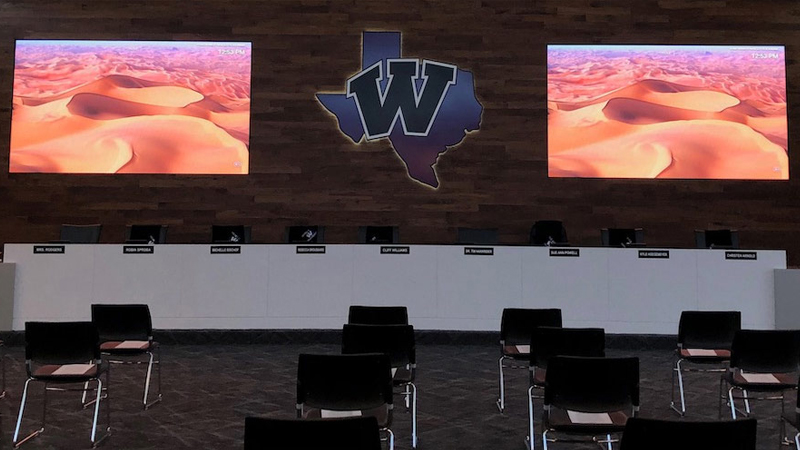Case Study: Willis ISD
Modern AV technology and expert integration changed the collaboration and communication game for a growing Texas K-12 school district.
Download the Case Study PDFWhile not quite generating the AV technology intrigue of K-12 classrooms, the administration building is, for all intents and purposes, the corporate pulse of the school district. This is where the decision-makers establish curriculum, coordinate budgets, and organize safety initiatives, for example. For many school districts, it’s also the headquarters from which they communicate with the public.
This wasn’t always the case for the Willis Independent School District (Willis ISD) in Texas, which in late 2020 finally moved into a central administration building after being spread over four locations for decades. The nine-campus K-12 district, located 45 miles north of Houston, is in one of the state’s fastest growing counties. The consolidation of administrative staff to one location establishes a far more efficient approach for managing the growing school district.
Building from the ground up also presented an opportunity to design a truly state-of-the-art facility. The $11 million budget included a generous slice for AV and IT systems. With Houston-based architectural firm Stantec in charge of overall facility design, the Willis ISD brought in CueBlue, also based in Houston, to specify, design and integrate AV systems for modern meeting spaces, training rooms and offices.
“We came in with a blank slate, which really gave us the option to custom-design the entire system to their specifications,” said Joseph Fertitta, CEO, CueBlue. “We wanted it to be modern, professional and of high quality, but above all we wanted simplicity. Without ease of use, it would ultimately be pointless.”
Cue the Design Stage
The architectural team provided some general specifications for the CueBlue team at the starting gate, which included insight into what components would be required for each space. The three large meeting spaces – a central boardroom, a divisible classroom, and a technology training room – would require most of the AV equipment and integration work. The plans also called for displays and mounting gear in eight smaller conference rooms and 12 administrative offices, as well as a corridor system for digital signage content.
The CueBlue team first needed to work on the foundation. The biggest challenge included some oddities in input/output configurations that, according to Fertitta, didn’t quite align with the idea of keeping things simple. “The training room was specified to matrix six inputs into four outputs, which was too complex for a fairly small space without divisible walls. We realized in the long run that they were really just trying to either get one input to all outputs, or one input to one output.”
The CueBlue team “refined the system down” to simplify operation, streamline I/O, and reduce costs. The 6×4 matrix concept would have been an easier sell had Willis ISD gone the AV over IP route. However, with no need to share content between spaces or scale beyond the initial AV system, Stantec specified a lower-cost HDBaseT™ infrastructure. Key components include Atlona switching and distribution gear to manage video signals in the board room, divisible classroom and training room. Symetrix DSP gear was specified to manage audio in parallel with Atlona’s video traffic in the board room and classroom. These systems were carefully matched to the Layer 1 infrastructure in each space.
IP In The Mix
Even with the decision to specify HDBaseT instead of AV over IP, there was still a need for some network components.
Netgear GS728TP 24-Port PoE network switches, isolated from the central IT infrastructure, were added to the board room and the divisible classroom to manage Atlona Velocity™ control signals; a smaller Netgear GS116LP was specified for the smaller training room. Since Velocity is a true IP-based control system, all control signals move in and out of the Netgear switches.
“The network switches are the core interconnect between Velocity and just about every other AV component in the system,” said Fertitta. “Atlona’s approach also gave us an array of configuration options to customize the control architecture, which included serving all of these rooms with one processor. We ultimately put a dedicated AT-VGW-HW3 Velocity Gateway in each of three main rooms to align with the district’s security protocols.”
Security concerns also influenced the decision for to create a physically isolated private network for AV and control traffic. “We had shared concerns about the information living on our core network infrastructure,” said Stephen Shannon, director of technology, Willis ISD. “CueBlue recommended we set up a private network that requires someone to be on site to access controls and management software, or would otherwise defer remote troubleshooting to CueBlue through temporary computer system access. This provided the security we desired, and ensures that the integrity of the systems are never compromised.”
The decision to separate systems by room also meant building out a dedicated rack and cabling infrastructure for the three big spaces. An electrical contractor was brought in to run most of the Cat6 cabling, with the CueBlue team adding some final connections and ensuring the pre-installed cables were properly terminated.
“We wanted (the AV system) to be modern, professional and of high quality, but above all we wanted simplicity. Without ease of use, it would ultimately be pointless.”
– Joseph Fertitta, CEO, CueBlue
Sized For Needs
CueBlue’s efforts to keep things simple for the client in some ways created a bigger challenge for them, room by room. That included carefully selecting the perfect matrix switcher for each space.
“Atlona has a broad range of matrix and wallplate switchers,” said Fertitta. “We were able to use the same 4×4 matrix switcher model (an AT-UHD-PRO3-44M) in the classroom and training room, but we needed to think differently in the board room.”
The board room is home to a monthly board meeting, along with specialty meetings that are often scheduled on short notice. Fertitta explains that the district needed a system that could accommodate a variety of connection options, since so many different people give presentations in this space.
“The original request was for HDMI and VGA, which has been the standard for AV wallplates for some time,” he said. “My goal was to ensure they were future-focused, which meant shifting the design to HDMI and USB-C. That is where the world is headed.”
The CueBlue team added Atlona AT-HDVS-210U-TX-WP* wallplate switchers on each side of the room to support USB-C connectivity. “These are perfectly positioned on each side of the room so that anyone can plug in, run an HDMI to the podium if needed and conduct a presentation. We also added an Apple TV on request to provide a third primary video input.”
(*The AT-HDVS-210U-TX-WP has been replaced with the AT-OME-SW21-TX-WPC as an HDMI and USB-C input wallplate for HDBaseT systems.)
CueBlue specified an Atlona AT-UHD-CLSO-824 as the core matrix switcher for the board room. This is a better fit than the AT-UHD-PRO3-44M for the more complex AV requirements of this space, which includes AV equipment not seen in the other two main rooms.
“The CLSO-824 gives us an 8×2 matrix to support the greater number of inputs that come from some unique AV elements compared to the other rooms,” said Fertitta. We needed something in this room with two parallel outputs, and the ability to handle at least three HDBaseT feeds. Its core functionality is perfect for this space.”
Post-switching, the Atlona AT-UHD-CLSO-824 sends content across what Fertitta calls “two distribution chains.” The first goes to MIMO UM-1080H HDMI monitors arranged across the front of the room. Each board member and the secretary have a personal monitor to watch presentations shown on the video walls. An Atlona AT-HDVS-150-RX HDBaseT scaler and receiver takes in the video prior to hitting the MIMO monitors, which Fertitta says offers more lock control over resolution scaling, especially when audio is passing through. Atlona Rondo 444 and 448 distribution amplifiers split the signals for delivery to the different monitors.
The second signal chain feeds two Absen iCon Video walls supported with NovaStar MCTRL-700 video wall control processors. Each processor feeds a separate video wall, with a Cat6 connection for each screen quadrant. The signal for the first NovaStar processor comes from an Atlona AT-HDVS-150-RX for image scaling. The second processor is daisy-chained to the first, and both pass video feeds to their respective video walls.
CueBlue specified a Symetrix Solus NX 16×8 networked DSP for audio traffic, which functions as an auto-mixer for the board members during meetings. “The DSP brings the volume down as needed,” said Fertitta. “There are a wide range of board members, and the Solus adapts to a range of voices from low and boomy to higher pitched. This keeps a check on leveling issues and eliminates the need for manual mixing.”
The Symetrix DSP is also routing the audio traffic, including Clockaudio C 8SW-RF-CP shotgun microphones that are suspended from the ceiling; and Sennheiser SpeechLine digital wireless handheld microphones.
“The Clockaudio mics pick up the voices of board members that might forget to activate their desktop microphones,” said Fertitta. “That is not unusual because often mute buttons are accidentally activated, or are pressed and simply forgotten as meetings progress. The SpeechLine base stations have a little LED that is lit red or green to show on/off status. We added five Sennheiser CHG-2W dual wireless tabletop charging stations that live in the adjacent board room. When the microphones are not charging, the pads can be used to charge wireless charging-capable devices, including smartphones.”
The Symetrix DSP also routes microphone audio to a Tascam SS-R250N solid-state audio recorder, which was installed to comply with meeting recording laws. The Atlona AT-UHD-CLSO-824 switcher sends its video feed to the Epiphan ESP-1440 for use in live streamed video presentations. The system records the video to a removable SD card and USB Flash Drive. The Tascam SS-R250N is fed from the DSP and is only capable of audio recording. It also uses a removable SD card to simplify file transport. Alternatively, users can securely connect to the Epiphan system to download stored video files direct to a personal computer.
“One of the more advanced features of this workflow is that we programmed the Atlona CLSO-824 switcher for record, start, stop and pause functionality with the Tascam recorder,” said Fertitta. “It is one of the more interesting programming elements we did for this entire project, along with the fully custom tailored GUIs for each space with Velocity touchscreen controls.”
A total of 16 Community D10 ceiling speakers provide sound reinforcement inside the board room and outside in the lobby area. Velocity controls allow the lobby feed to be turned on and off as needed.
Powered by a Crown DCi two-channel amplifier, CueBlue
co-owner Bill Sellers personally specified Community loudspeakers for the board room, citing their enhanced directionality as a deciding factor. “We needed a full-range speaker with a dispersion pattern that met the needs of the room,” said Sellers. “The Community speakers worked well for us in a similar application, and were recommended by both Community and our friends at Biamp.”
Similar technology is used across the divisible classroom and the technology training room, though there are some important differences. The divisible classroom is the closest to the board room in technical infrastructure, though drops some components like the camera, scalers and distribution amplifiers.
The latter two were not required since video walls were not added to this room; instead, three Vivitek DH3660Z DLP laser projectors and three Draper projections screens (one 92-inch and two 119-inch) show video content to attendees. The signal flow starts with three AT-HDVS-210U-TX-WP wallplate that feed Atlona Omega™ AT-OME-RX11 receivers, which also provide power to the wallplates. The HDMI signal then goes to the matrix switcher; the switcher’s three HDBaseT outputs feed three Atlona AT-UHD-EX-100CE-RX HDBaseT receivers, which send HDMI signals to the Vivitek projectors.
Twelve JBL Control 47HC ceiling speakers provide sound reinforcement across the classroom; the JBLs were chosen for this space due to a tighter dispersion pattern, which is critical when the room is divided for simultaneous events.
“The divisible classroom was originally supposed to be three distinct spaces, but became two through budget reconciliation,” said Fertitta. “That said, it was still important to support three video feeds in this room. This is a long rectangular room, and there is a wall-mount Draper screen on each end.”
The third screen is a custom recessed Draper screen that can be used in the middle of the room against either side of the divisible wall. “When they set this up as two rooms facing opposite directions with the air wall closed, people can look at the projection screens on the ends of the room,” he continued, “Or, they can open it all up and rotate everything to be a short-depth, long-width room.”
The technology training space is exclusively dedicated to video gear, with four Atlona AT-UHD-EX-100CE-RX HDBaseT receivers feeding content for Vivitek DH765Z-UST ultra-short throw DSP laser projector and three LG 65-inch UHD LCD displays.
“This is really a learning space for trainings and certification courses,” said Fertitta. “However, it doubles as a mixed-use space. They were throwing a birthday party for an employee on a recent visit. It gives them a comfortable space to accommodate events that might need video, but really shouldn’t be done in the board room and classroom.”
Personnel Matters
The AV is as simple as it gets outside of these spaces. The eight conference rooms and twelve offices are exact replicas, with eight 65-inch LG displays. All displays are mounted with Peerless PT650 wall-mount systems, which provides some control over tilt to help with glare from the overhead lights.
For Shannon, the entire project represents a leap forward not only in terms of AV infrastructure, but also how they collaborate internally and communicate with the public.
“At our prior building, we had one training space that was used for multiple purposes and we were sometimes limited to what we could do,” he said. “We now have several different areas that serve different purposes. The board room has large LED screens that is conducive to presenting information. We have a dedicated training room for large group instruction, with multiple screens and projectors. There is the ability to display different information on the different screens and split the room in half if needed. Upstairs, we have a small group collaboration room with one projector and three smaller displays. We can even separate into even smaller groups and still see the information projected.”
Shannon and Fails agree that CueBlue is the glue that brought the district’s entire AV vision together. Both comment about the ease of use of the entire AV ecosystem, noting the Atlona Velocity touch panels in each of the three rooms as an example. CueBlue installed Velocity AT-VTP-800-WH 8-inch control panels in each space.
“The Velocity touch panels greatly simplify and unify the process of controlling the AV in a room so that we can spend our time on other things,” said Shannon. This also allows for multiple AV inputs in one space. CueBlue even helped us integrate our AppleTVs that we use as a video option on these control panels.
“The needs of every school district vary, and with technology constantly changing it is important that districts thinking about their specific needs, feel comfortable with their chosen integration company, and ultimately receive the highest level and quality of design and installation,” he continued. “CueBlue brought an extremely customized solution to Willis ISD that allows us to meet multiple different needs in one building, whether that is a whole group presentation, large group training, or small group collaborative sessions. We are very happy with the solutions and the expertise they provided.”
“Atlona’s approach also gave us an array of configuration options to customize the control architecture, which included serving all of these rooms with one processor. We ultimately put a dedicated AT-VGW-HW3 Velocity Gateway in each of three main rooms to align with the district’s security protocols.”
-Fertitta
| PRODUCTS FEATURED | ||
| Model | Description | Image |
| AT-HDVS-150-RX | The Atlona AT-HDVS-150-RX is an HDBaseT receiver and HD scaler for video signals up to 1080p, plus embedded audio over distances up to 230 feet (70 meters). | 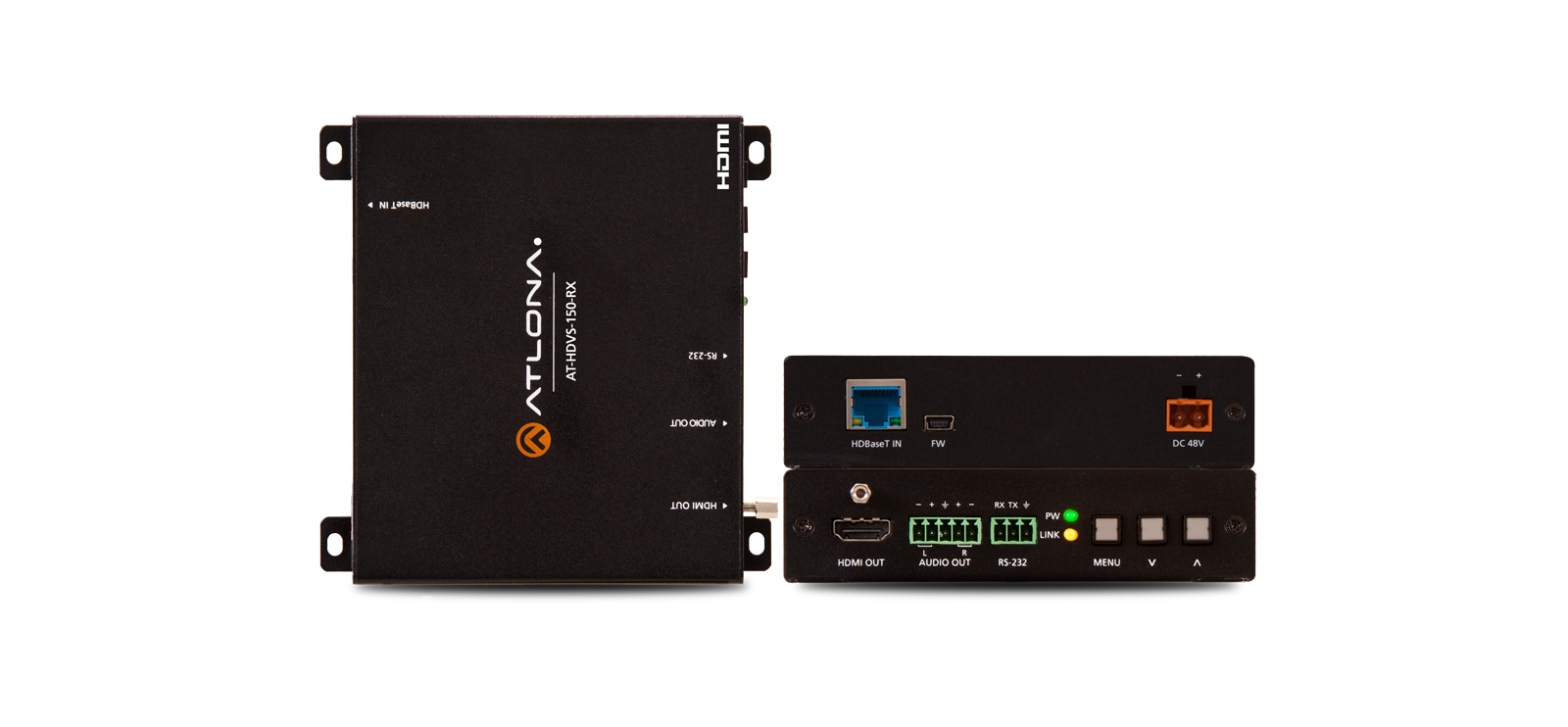 |
| AT-UHD-PRO3-44M | The AT-UHD-PRO3-44M is an HDMI to HDBaseT matrix switcher with PoE for 4K /UHD @ 60 Hz video signals with Power over Ethernet for receivers and analog audio breakout. The matrix provides both extended distance, 330 foot (100 meter) and long distance, 230 foot (70 meter) HDBaseT transmission over category cable. |  |
| Atlona Rondo™ Series | The Atlona Rondo™ 444 and 442 (AT-RON-444 & AT-RON-442) are HDMI distribution amplifiers for high dynamic range (HDR) formats. They are HDCP 2.2 compliant and supports 4K /UHD video @ 60 Hz with 4:4:4 chroma sampling, as well as HDMI data rates up to 18 Gbps. | 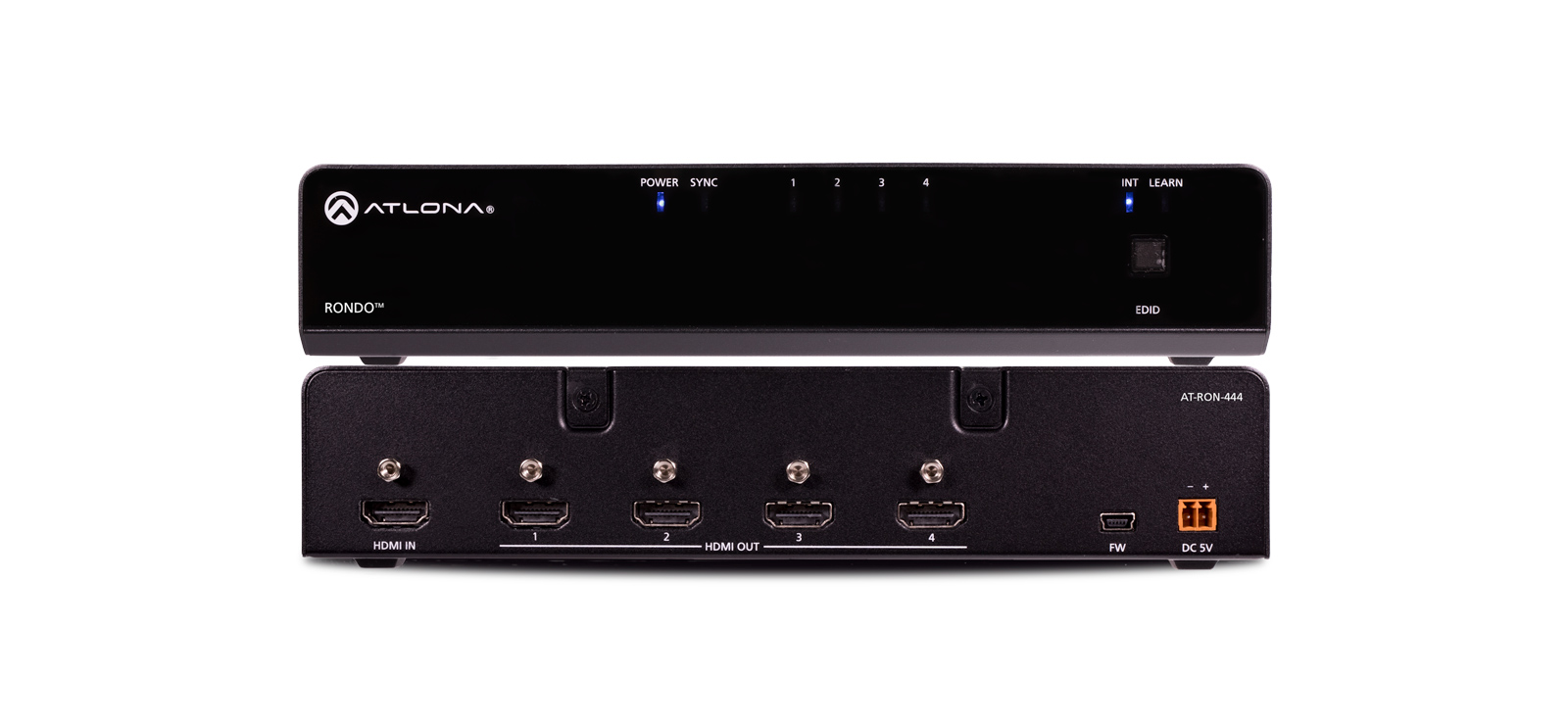 |
| AT-OME-RX11 | The Atlona AT-OME-RX11 is an HDBaseT receiver for video up to 4K/60 4:2:0, plus embedded audio, control, and Ethernet over distances up to 330 feet (100 meters). Part of the Omega™ Series of integration products for modern AV communications and collaboration, the OME-RX11 is HDCP 2.2 compliant and receives RS-232 and IP control signals. | 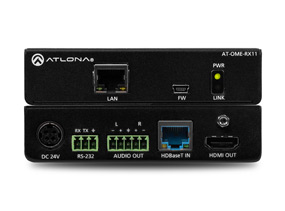 |
| AT-UHD-CLSO-824 | The Atlona AT-UHD-CLSO-824 is a 4K /UHD 8×2 matrix switcher with dual, HDBaseT and mirrored HDMI outputs for 4K /UHD @ 60Hz signals. This matrix switcher has multi-format signal-handling, Ethernetenabled 100-meter HDBaseT™ input/output extension, and advanced audio capabilities. | 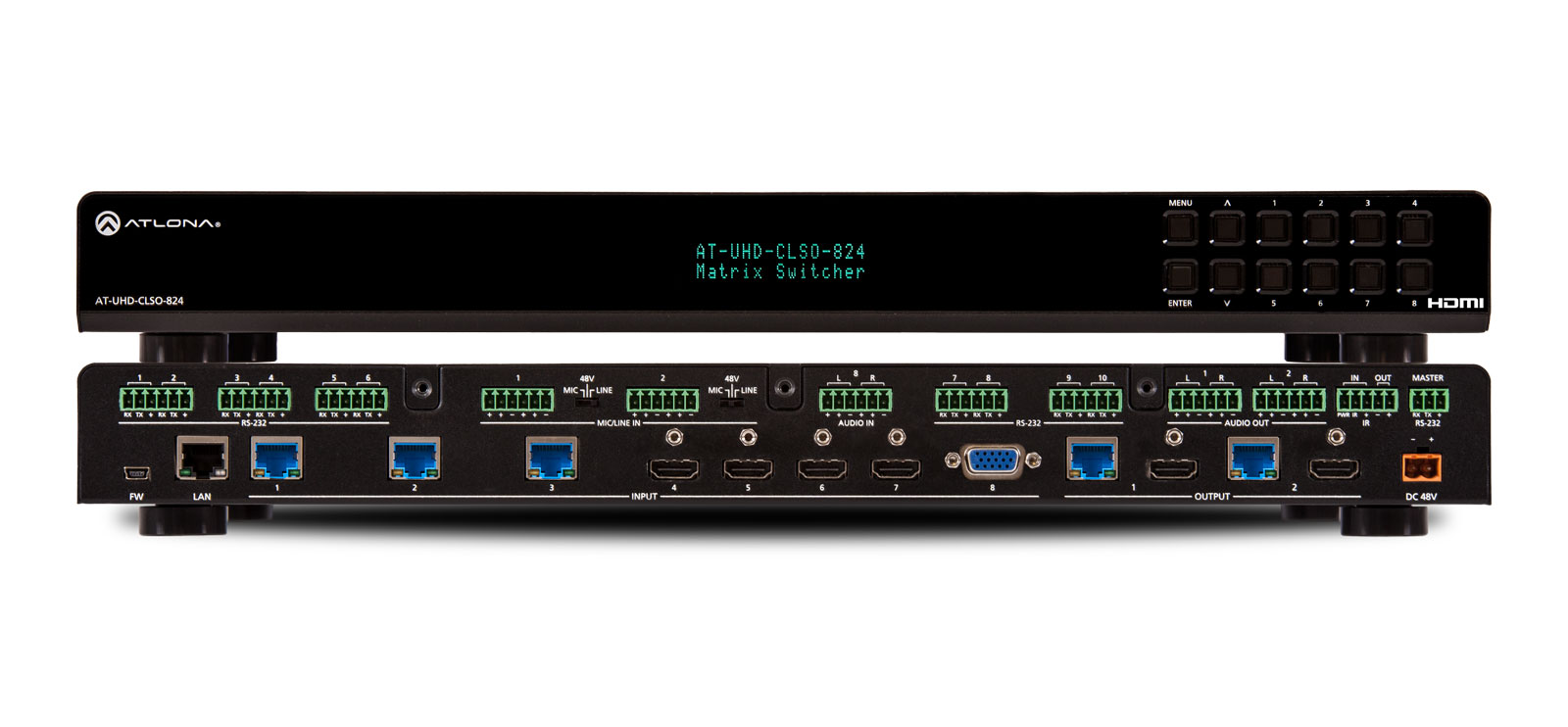 |
| AT-VGW-HW | The Atlona AT-VGW- HW-3 is an Atlona Velocity™ System server gateways for AV system control, plus room scheduling and AV asset management. These gateways feature a compact enclosure that easily installs into a rack. | 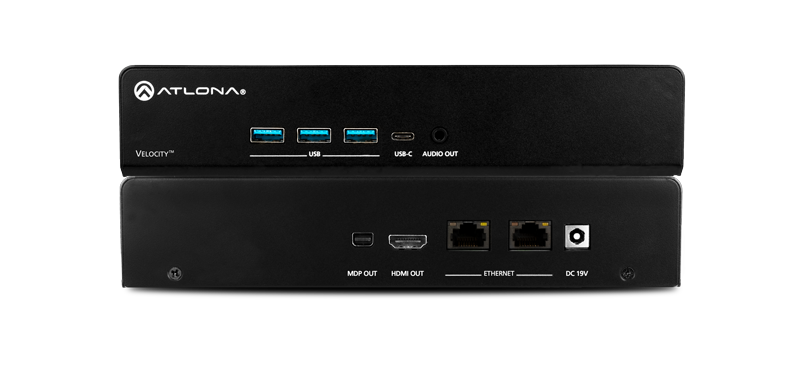 |
| AT-VTP-800 | T he Atlona AT-VTP-800 is a Velocity System 8" touch panel for AV control and room scheduling. It features contemporary, refined styling for modern presentation environments with 1280×800 native resolution, and a capacitive glass surface that supports multi-touch and gesture interactions. |  |
| AT-UHD-EX-100CE-RX | The Atlona AT-UHD-EX-100CE-RX is a 4K / UHD HDMI over 10 0M HDBaseT receiver for AV signals up to 330 feet (10 0 meters) over category cable with Ethernet, RS -232, and IR control pass-through, plus Power over Ethernet. | 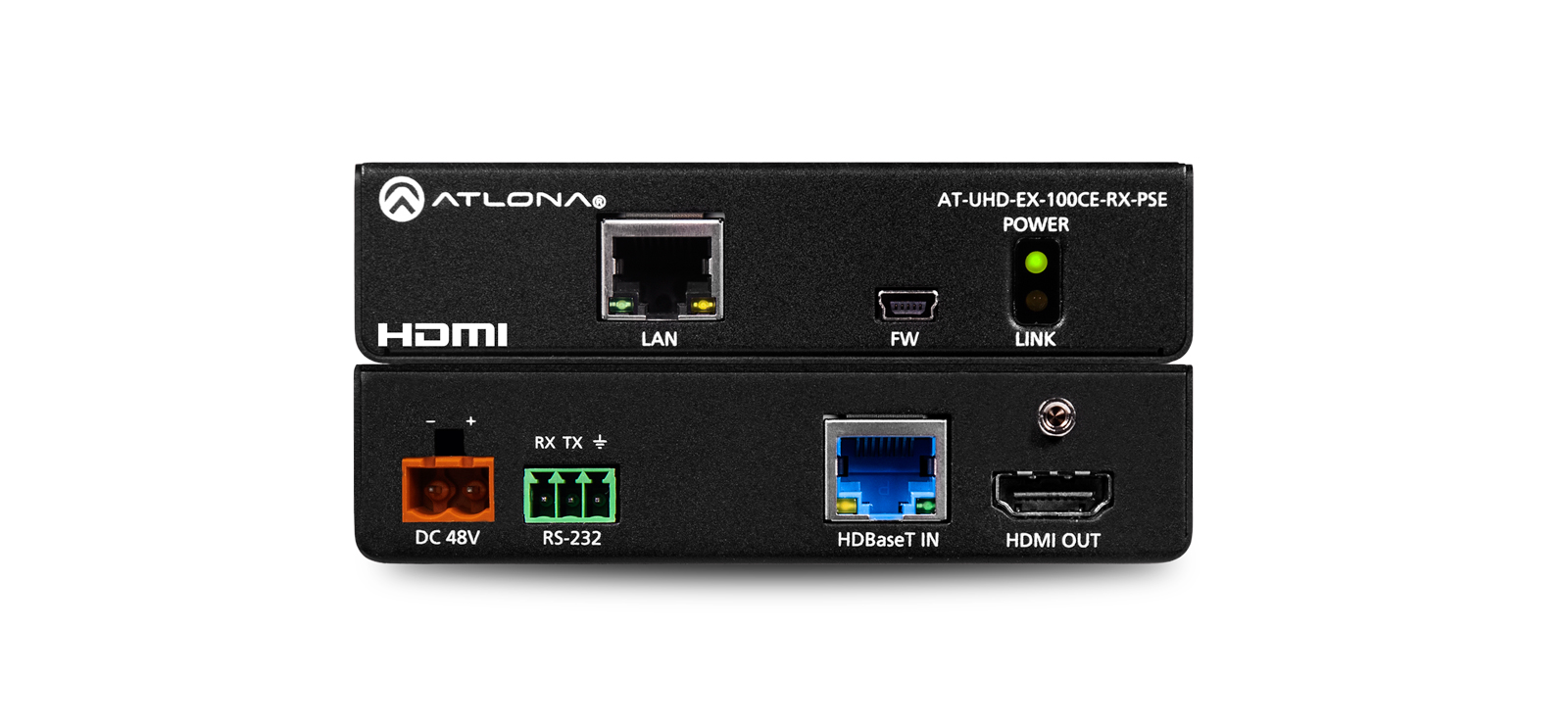 |







